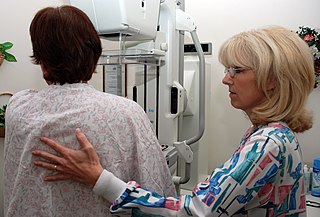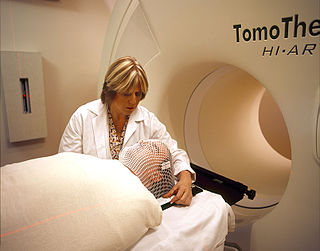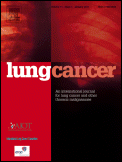
Hemangiosarcoma is a rapidly growing, highly invasive variety of cancer that occurs almost exclusively in dogs, and only rarely in cats, horses, mice, or humans. It is a sarcoma arising from the lining of blood vessels; that is, blood-filled channels and spaces are commonly observed microscopically. A frequent cause of death is the rupturing of this tumor, causing the patient to rapidly bleed to death.

A detection dog or sniffer dog is a dog that is trained to use its senses to detect substances such as explosives, illegal drugs, wildlife scat, currency, blood, and contraband electronics such as illicit mobile phones. The sense most used by detection dogs is smell. Hunting dogs that search for game, and search and rescue dogs that work to find missing humans are generally not considered detection dogs but fit instead under their own categories. There is some overlap, as in the case of cadaver dogs, trained to search for human remains.

Personalized medicine, also referred to as precision medicine, is a medical model that separates people into different groups—with medical decisions, practices, interventions and/or products being tailored to the individual patient based on their predicted response or risk of disease. The terms personalized medicine, precision medicine, stratified medicine and P4 medicine are used interchangeably to describe this concept, though some authors and organizations differentiate between these expressions based on particular nuances. P4 is short for "predictive, preventive, personalized and participatory".
Canine cancer detection is an approach to cancer screening that relies upon the claimed olfactory ability of dogs to detect, in urine or in breath, very low concentrations of the alkanes and aromatic compounds generated by malignant tumors. While some research has been promising, no verified studies by secondary research groups have substantiated the validity of positive, conclusive results.

Alternative cancer treatment describes any cancer treatment or practice that is not part of the conventional standard of cancer care. These include special diets and exercises, chemicals, herbs, devices, and manual procedures. Most alternative cancer treatments do not have high-quality evidence supporting their use and many have been described as fundamentally pseudoscientific. Concerns have been raised about the safety of some purported treatments and some have been found unsafe in clinical trials. Despite this, many untested and disproven treatments are used around the world.

Cancer is the leading cause of death in dogs. It is estimated that 1 in 3 domestic dogs will develop cancer, which is the same incidence of cancer among humans. Dogs can develop a variety of cancers and most are very similar to those found in humans. Dogs can develop carcinomas of epithelial cells and organs, sarcomas of connective tissues and bones, and lymphomas or leukemias of the circulatory system. Selective breeding of dogs has led certain pure-bred breeds to be at high-risk for specific kinds of cancer.

Clinical Lung Cancer is a peer-reviewed medical journal that has been published by Elsevier since 2011. It was established by the CIG Media Group in 1999.
Karol Sikora is a British physician specialising in oncology, who has been described as a leading world authority on cancer. He was a founder and medical director of Rutherford Health, a company that provided proton therapy services, and is Director of Medical Oncology at the Bahamas Cancer Centre.

Oncology is a branch of medicine that deals with the study, treatment, diagnosis, and prevention of cancer. A medical professional who practices oncology is an oncologist. The name's etymological origin is the Greek word ὄγκος (ónkos), meaning "tumor", "volume" or "mass". Oncology is concerned with:

The objective of cancer screening is to detect cancer before symptoms appear, involving various methods such as blood tests, urine tests, DNA tests, and medical imaging. The purpose of screening is early cancer detection, to make the cancer easier to treat and extending life expectancy. In 2019, cancer was the second leading cause of death globally; more recent data is pending due to the COVID-19 pandemic.

Bone metastasis, or osseous metastatic disease, is a category of cancer metastases that result from primary tumor invasions into bones. Bone-originating primary tumors such as osteosarcoma, chondrosarcoma, and Ewing sarcoma are rare; the most common bone tumor is a metastasis. Bone metastases can be classified as osteolytic, osteoblastic, or both. Unlike hematologic malignancies which originate in the blood and form non-solid tumors, bone metastases generally arise from epithelial tumors and form a solid mass inside the bone. Bone metastases, especially in a state of advanced disease, can cause severe pain, characterized by a dull, constant ache with periodic spikes of incident pain.

Cancer treatments are a wide range of treatments available for the many different types of cancer, with each cancer type needing its own specific treatment. Treatments can include surgery, chemotherapy, radiation therapy, hormonal therapy, targeted therapy including small-molecule drugs or monoclonal antibodies, and PARP inhibitors such as olaparib. Other therapies include hyperthermia, immunotherapy, photodynamic therapy, and stem-cell therapy. Most commonly cancer treatment involves a series of separate therapies such as chemotherapy before surgery. Angiogenesis inhibitors are sometimes used to enhance the effects of immunotherapies.

Lung Cancer is a peer-reviewed medical journal published by Elsevier originally published on behalf of the International Association for the Study of Lung Cancer. As of 2015, it is published on behalf of the International Lung Cancer Consortium, the European Thoracic Oncology Platform, and the British Thoracic Oncology Group. It includes original research and review articles of relevance to lung cancer.

A cancer biomarker refers to a substance or process that is indicative of the presence of cancer in the body. A biomarker may be a molecule secreted by a tumor or a specific response of the body to the presence of cancer. Genetic, epigenetic, proteomic, glycomic, and imaging biomarkers can be used for cancer diagnosis, prognosis, and epidemiology. Ideally, such biomarkers can be assayed in non-invasively collected biofluids like blood or serum.
Dynamic angiothermography (DATG) is a technique for the diagnosis of breast cancer. This technique, though springing from the previous conception of thermography, is based on a completely different principle. DATG records the temperature variations linked to the vascular changes in the breast due to angiogenesis. The presence, change, and growth of tumors and lesions in breast tissue change the vascular network in the breast. Consequently, through measuring the vascular structure over time, DATG effectively monitors the change in breast tissue due to tumors and lesions. It is currently used in combination with other techniques for diagnosis of breast cancer. This diagnostic method is a low-cost one compared with other techniques.

Molecular diagnostics is a collection of techniques used to analyze biological markers in the genome and proteome, and how their cells express their genes as proteins, applying molecular biology to medical testing. In medicine the technique is used to diagnose and monitor disease, detect risk, and decide which therapies will work best for individual patients, and in agricultural biosecurity similarly to monitor crop- and livestock disease, estimate risk, and decide what quarantine measures must be taken.
Kathleen I. Pritchard, is the head of oncology at Sunnybrook Health Sciences Centre in Toronto, Canada, specializing in breast cancer therapies, and leading the clinical trials division of the centre. She has authored numerous studies on women's health, breast cancer, hormone replacement therapy, public health, and research methodology. According to Thomson Reuters, Pritchard was one of the most cited researchers in the world in 2014 and 2015.

Tongue diagnosis in Chinese Medicine is a method of diagnosing disease and disease patterns by visual inspection of the tongue and its various features. It is one of the major diagnostic methods in Chinese Medicine since the time of the Yellow Emperor's Inner Classic. It is considered a part of the “Inspection” method within the four methods of diagnosis. Practitioners claim that the tongue provides important clues reflecting the conditions of the internal organs. Like other diagnostic methods in Traditional Chinese Medicine, tongue diagnosis is based on the “outer reflects the inner” principle, which is that external structures often reflect the conditions of the internal structures and can give us important indications of internal disharmony.
Smell as evidence of disease has been long used, dating back to Hippocrates around 400 years BCE. It is still employed with a focus on volatile organic compounds (VOCs) found in body odor. VOCs are carbon-based molecular groups having a low molecular weight, secreted during cells' metabolic processes. Their profiles may be altered by diseases such as cancer, metabolic disorders, genetic disorders, infections, and among others. Abnormal changes in VOC composition can be identified through equipment such as gas chromatography-mass spectrometry(GC-MS), electronic nose (e-noses), and trained non-human olfaction.
Richard James Cote is a pathologist, academic and author. He is the Edward Mallinckrodt Professor and Chair of the Department of Pathology and Immunology at Washington University in St. Louis School of Medicine, and the Pathologist-in-Chief at Barnes Jewish Hospital.














